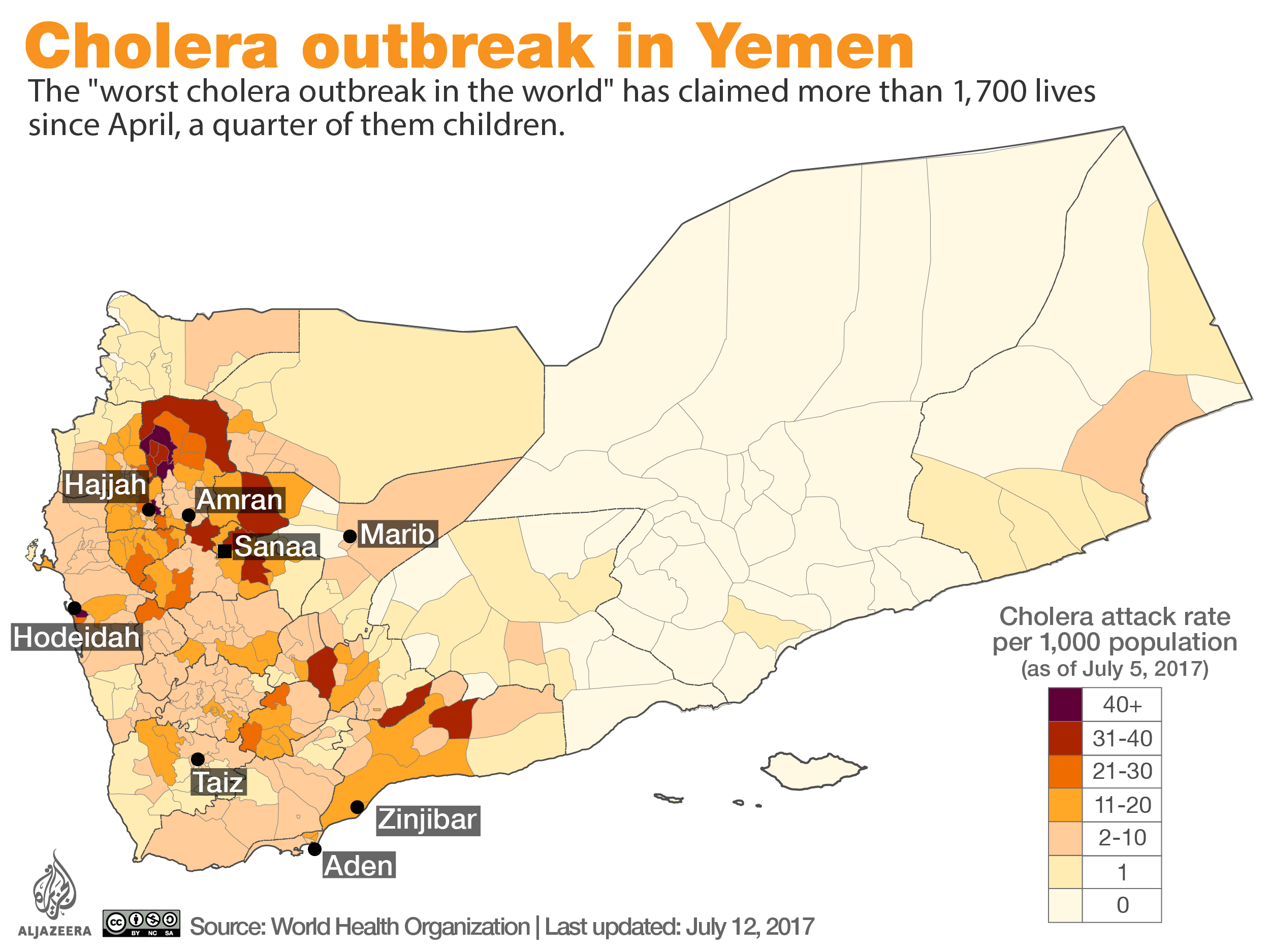
OCTOBER 18, 2017
The cholera epidemic in Yemen is now the largest and fastest growing outbreak of the disease in modern history — the result of a crippling war that has devastated the country, long the poorest in the Arab world, and unleashed a major humanitarian crisis.
At last count on October 11, the World Health Organization reported that there have been more than 822,000 suspected cases of cholera and 2,160 cholera-related deaths since the end of April, when the outbreak emerged. The crisis has become so severe that approximately 5,000 Yemenis experience cholera symptoms each day, said Christian Lindmeier, a World Health Organization spokesman.
Yemen’s outbreak has already surpassed the epidemic in Haiti, which has reported 815,000 cases of cholera and 9,700 deaths since 2010, according to the United Nations. But while it took Haiti seven years to reach those numbers, cholera has consumed Yemen in a mere six months.
“It’s certainly an unprecedented epidemic with the number of cases happening in the period of time,” said Louise Ivers, executive director of the Center for Global Health at Massachusetts General Hospital. “It’s definitely the worst epidemic the world is currently dealing with.”
While experts acknowledge that it’s difficult to compare the two countries, they do agree that what’s happening on the ground in Yemen is nothing short of catastrophic. During a September news briefing in Geneva, the International Committee of the Red Cross said that the country could hit a million cholera cases by the end of the year.
What’s especially troubling, experts say, is that the outbreak was entirely man-made — the result of the violence that erupted in 2014 when the Houthis, a rebel group from the north of Yemen, seized the capital of Sanaa. Months later, a coalition led by the region’s wealthiest nation, Saudi Arabia, began bombing Yemen, compounding the bloodshed. The death toll has reached more than 10,000, with another 7 million Yemenis facing famine.
“The biggest issue is the man-made crisis; it’s the war,” Lindmeier said. “The conflict has destroyed so much and prevents anything from restoring. So, unless there is peace, unless the war is over, unless the conflict stops, this country will not stop having disease outbreaks and health problems.”
A combination of factors instigated by the war led to the cholera outbreak, eventually amplifying the epidemic beyond control. For example, after the Saudi-led bombing campaign began, the government stopped paying civil servants. Sanitation workers went on strike in response to unpaid wages, leading to garbage pile-ups on the streets and septic backups. When the rains came, water washed through the garbage, bringing dangerous bacteria into the water supply.
At the same time, the bombing devastated the country’s already fragile health system. Today, more than 55 percent of all Yemeni health facilities are closed or only partially functional, while nearly 15 million people lack access to basic health care, according to the WHO.
Since 2016, the government also hasn’t paid health workers’ regular salaries, prompting some international organizations to step in and pay Yemen’s doctors and nurses. In total, an estimated 1.25 million public employees have not been paid regularly for more than 10 months, according to the U.N.
Ghassan Abou Chaar, the Doctors Without Borders head of mission in Yemen, said that health facilities aren’t receiving critical operational costs, making it nearly impossible for them to properly function. Additionally, many families are unable to seek out care, whether it’s because they must now travel far to find a working facility or simply can’t afford it. Those who do travel for care run the risk of infecting others along the way — with that risk only growing the further they have to travel.
“What we have in Yemen is really the perfect storm. You have a country which has been in civil war for quite some time, you have conflict which disrupts and destroys the health system, which puts people on the run, which prevents that people go to their normal healthcare provider,” Lindmeier said. “Of course in that situation, with the health systems and sanitation systems destroyed, diseases like cholera spread easily.”
Doctors Without Borders has opened 16 cholera treatment centers in response to the conflict, according to Chaar, and in the first five months of the outbreak, the organization treated more than 80,000 Yemenis. He said he’ll never forget visiting one of the centers and coming across a mother and her five children, all bed-ridden and vomiting.
While one million doses of an emergency oral cholera vaccine from a global stockpile, facilitated by the U.N., were initially approved for Yemen in June to assist with the outbreak, they later suspended the plans, citing the disease’s rapid spread across the country and the difficulty of delivering vaccines in a conflict zone. Lindmeier said that sending vaccines in the middle of an outbreak would have been ineffective, since their main function is as a preventative tool for those not yet affected.
Instead, he said his organization has employed interventions such as establishing rehydration points across the country, bringing in medical staff and providing cholera kits, which include materials ranging from water purification tablets to soap and disinfectants.
The U.N. also revised its humanitarian response plan for Yemen in August to $2.3 billion. However, about $1 billion, or 44 percent of those funds, have yet to be received, a U.N. spokesperson said.
Going forward, experts worry that lack of basic health care in Yemen will have implications that go far beyond cholera and eventually seep into all facets of public health — from a cancer patient unable to access a hospital for treatment to an expectant mother who can’t safely give birth.
“The collapse of the health system has been one of the causes to have such a bad cholera outbreak, but what we are afraid of is what is coming after, which could be an outbreak of other diseases that could be much more dangerous,” Chaar said. “We are worried that this could be just the start.”
http://www.pbs.org/wgbh/frontline/article/how-yemens-cholera-outbreak-became-the-fastest-growing-in-modern-history/






0 Comments